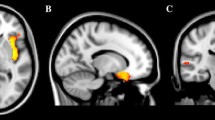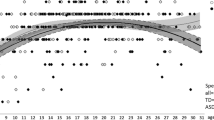Abstract
The medial prefrontal cortex (mPFC) and the right temporo-parietal junction (rTPj) are highly involved in social understanding, a core area of impairment in autism spectrum disorder (ASD). We used fMRI to investigate sex differences in the neural correlates of social understanding in 27 high-functioning adults with ASD and 23 matched controls. There were no differences in neural activity in the mPFC or rTPj between groups during social processing. Whole brain analysis revealed decreased activity in the posterior superior temporal sulcus in males with ASD compared to control males while processing social information. This pattern was not observed in the female sub-sample. The current study indicates that sex mediates the neurobiology of ASD, particularly with respect to processing social information.


Similar content being viewed by others
References
Abell, F., Happe, F., & Frith, U. (2000). Do triangles play tricks? Attribution of mental states to animated shapes in normal and abnormal development. Cognitive Development, 15, 1–16.
Alaerts, K., Woolley, D. G., Steyaert, J., Di Martino, A., Swinnen, S. P., & Wenderoth, N. (2014). Underconnectivity of the superior temporal sulcus predicts emotion recognition deficits in autism. Social Cognitive and Affective Neuroscience, 9(10), 1589–1600.
American Psychiatric Association. (2013). Diagnostic and statistical manual of mental disorders (5th ed.). Washington, DC: American Psychiatric Publishing.
Attwood, T. (2007). The complete guide to asperger’s syndrome. London: Jessica Kingsley Publishers.
Austin, E. J. (2005). Personality correlates of the broader autism phenotype as assessed by the Autism Spectrum Quotient (AQ). Personality and Individual Differences, 38, 451–460.
Baron-Cohen, S., Leslie, A. M., & Frith, U. (1985). Does the autistic child have a “theory of mind”? Cognition, 21, 37–46.
Baron-Cohen, S., & Wheelwright, S. (2004). The empathy quotient: An investigation of adults with Asperger syndrome or high functioning autism, and normal sex differences. Journal of Autism and Developmental Disorders, 34, 163–175.
Baron-Cohen, S., Wheelwright, S. J., Skinner, R., Martin, J., & Clubley, E. (2001). The autism-spectrum quotient (AQ): Evidence of Asperger’s syndrome/high functioning autism, males and females, scientists and mathematicians. Journal of Autism and Developmental Disorders, 31, 5–17.
Beacher, F., et al. (2012). Autism attenuates sex differences in brain structure: A combined voxel-based morphometry and diffusion tensor imaging study. American Journal of Neuroradiology, 33, 83–89.
Bloss, C. S., & Courchesne, E. (2007). MRI neuroanatomy in young girls with autism: A preliminary study. Journal of the American Academy of Child and Adolescent Psychiatry, 46, 515–523.
Brett, M., Anton, J.-L., Valabregue, R., & Poline, J.-B. (2002). Region of interest analysis using the MarsBar toolbox for SPM 99. Neuroimage, 16, S497.
Castelli, F., Frith, C., Happe, F., & Frith, U. (2002). Autism, Asperger syndrome and brain mechanisms for the attribution of mental states to animated shapes. Brain, 125, 1839–1849.
Castelli, F., Happe, F., Frith, U., & Frith, C. (2000). Movement and mind: A functional imaging study of perception and interpretation of complex intentional movement patterns. NeuroImage, 12, 314–325.
CDC. (2014). Prevalence of autism spectrum disorders among children aged 8 years—Autism and developmental diabilities monitoring network, 11 sites, United states, 2010. Morbidity and Mortality Weekly Report, 63, 1–22.
Dufour, N., et al. (2013). Similar brain activation during false belief tasks in a large sample of adults with and without autism. PLoS One, 8, e75468.
Falkmer, T., Anderson, K., Falkmer, M., & Horlin, C. (2013). Diagnostic procedures in autism spectrum disorders: A systematic literature review. European Child and Adolescent Psychiatry, 22, 329–340.
Fein, D., et al. (2013). Optimal outcome in individuals with a history of autism. Journal of Child Psychology and Psychiatry, 54, 195–205.
Fombonne, E. (2003). Epidemiological surveys of autsim and other prevasive developmental disorders: An update. Journal of Autism and Developmental Disorders, 33, 365–382.
Fombonne, E. (2009). Epidemiology of pervasive developmental disorders. Pediatric Research, 65, 591–598.
Frith, C. D., & Frith, U. (1999). Interacting minds–a biological basis. Science, 286, 1692–1695.
Gallagher, H. L., & Frith, C. D. (2003). Functional imaging of ‘theory of mind’. Trends in Cognitive Sciences, 7, 77–83.
Gotham, K., Pickles, A., & Lord, C. (2012). Trajectories of autism severity in children using standardized ADOS scores. Pediatrics, 130, e1278–e1284.
Holt, R., et al. (2014). ‘Reading the Mind in the Eyes’: An fMRI study of adolescents with autism and their siblings. Psychological Medicine, 44, 3215–3227.
Kana, R. K., Libero, L. E., Hu, C. P., Deshpande, H. D., & Colburn, J. S. (2014). Functional brain networks and white matter underlying theory-of-mind in autism. Social Cognitive and Affective Neuroscience, 9, 98–105.
Kirkovski, M., Enticott, P. G., & Fitzgerald, P. B. (2013). A review of the role of female gender in autism spectrum disorders. Journal of Autism and Developmental Disorders, 43, 2584–2603. doi:10.1007/s10803-013-1811-1.
Kirkovski, M., Enticott, P. G., Maller, J. J., Rossell, S. L., & Fitzgerald, P. B. (2015). Diffusion tensor imaging reveals no white matter impairments among adults with autism spectrum disorder. Psychiatry Research: Neuroimaging. doi:10.1016/j.pscychresns.2015.05.003
Kopp, S., & Gillberg, C. (2011). The Autism Spectrum Screening Questionnaire (ASSQ)-Revised Extended Version (ASSQ-REV): An instrument for better capturing the autism phenotype in girls? A preliminary study involving 191 clinical cases and community controls. Research in Developmental Disabilities, 32, 2875–2888.
Lai, M.-C., et al. (2013). Biological sex affects the neurobiology of autism. Brain, 136, 2799–2815.
Lee, S. M., Gao, T., & McCarthy, G. (2014). Attributing intentions to random motion engages the posterior superior temporal sulcus. Social Cognitive and Affective Neuroscience, 9, 81–87.
Lombardo, M. V., Chakrabarti, B., Bullmore, E. T., & Baron-Cohen, S. (2011). Specialization of right temporo-parietal junction for mentalizing and its relation to social impairments in autism. NeuroImage, 56, 1832–1838.
Lovén, J., Svärd, J., Ebner, N. C., Herlitz, A., & Fischer, H. (2013). Face gender modulates women’s brain activity during face encoding. Social Cognitive and Affective Neuroscience, 9, 1000–1005.
Mainieri, A. G., Heim, S., Straube, B., Binkofski, F., & Kircher, T. (2013). Differential role of the Mentalizing and the Mirror Neuron system in the imitation of communicative gestures. NeuroImage, 81, 294–305.
Mathersul, D., McDonald, S., & Rushby, J. A. (2013). Understanding advanced theory of mind and empathy in high-functioning adults with autism spectrum disorder. Journal of Clinical and Experimental Neuropsychology, 35, 655–668.
Matson, J. L., & Williams, L. W. (2014). Depression and mood disorders among persons with Autism Spectrum Disorders. Research in Developmental Disabilities, 35, 2003–2007.
McLennan, J. D., Lord, C., & Schopler, E. (1993). Sex differences in higher functioning people with autism. Journal of Autism and Developmental Disorders, 23, 217–227.
Oldfield, R. C. (1971). The assessment and analysis of handedness: The Edinburgh inventory. Neuropsychologia, 9, 97–113.
Philip, R., Dauvermann, M. R., Whalley, H. C., Baynham, K., Lawrie, S. M., & Stanfield, A. C. (2012). A systematic review and meta-analysis of the fMRI investigation of autism spectrum disorders. Neuroscience and Biobehavioral Reviews, 36, 901–942.
Rajendran, G., & Mitchell, P. (2007). Cognitive theories of autism. Developmental Review, 27, 224–260.
Redcay, E., & Courchesne, E. (2005). When is the brain enlarged in autism? A meta-analysis of all brain size reports. Biological Psychiatry, 58, 1–9.
Ritvo, R. A., et al. (2011). The Ritvo Autism Asperger diagnostic scale-revised (RAADS-R): A scale to assist the diagnosis of autism spectrum disorder in adults—An international validation study. Journal of Autism and Developmental Disorders, 41, 1076–1089.
Saxe, R., & Powell, L. J. (2006). It’s the thought that counts specific brain regions for one component of theory of mind. Psychological Science, 17, 692–699.
Saxe, R., Xiao, D.-K., Kovacs, G., Perrett, D., & Kanwisher, N. (2004). A region of right posterior superior temporal sulcus responds to observed intentional actions. Neuropsychologia, 42, 1435–1446.
Schaafsma, S. M., Pfaff, D. W., Spunt, R. P., & Adolphs, R. (2015). Deconstructing and reconstructing theory of mind. Trends in Cognitive Sciences, 19, 65–72.
Scheeren, A. M., de Rosnay, M., Koot, H. M., & Begeer, S. (2013). Rethinking theory of mind in high-functioning autism spectrum disorder. Journal of Child Psychology and Psychiatry, 54, 628–635.
Schumann, C. M., et al. (2009). Amygdala enlargement in toddlers with autism related to severity of social and communication impairments. Biological Psychiatry, 66, 942–949.
Schumann, C. M., et al. (2010). Longitudinal magnetic resonance imaging study of cortical development through early childhood in autism. The Journal of Neuroscience, 30, 4419–4427.
Schurz, M., Radua, J., Aichhorn, M., Richlan, F., & Perner, J. (2014). Fractionating theory of mind: A meta-analysis of functional brain imaging studies. Neuroscience & Biobehavioral Reviews, 42, 9–34.
Silani, G., Bird, G., Brindley, R., Singer, T., Frith, C., & Frith, U. (2008). Levels of emotional awareness and autism: An fMRI study. Social Neuroscience, 3, 97–112.
Stoesz, B. M., Montgomery, J. M., Smart, S. L., & Hellsten, L.-A. M. (2011). Review of five instruments for the assessment of Asperger’s disorder in adults. The Clinical Neuropsychologist, 25, 376–401.
Van Overwalle, F. (2011). A dissociation between social mentalizing and general reasoning. Neuroimage, 54, 1589–1599.
Van Overwalle, F., & Baetens, K. (2009). Understanding others’ actions and goals by mirror and mentalizing systems: A meta-analysis. Neuroimage, 48, 564–584.
Wang, A. T., Lee, S. S., Sigman, M., & Dapretto, M. (2007). Reading affect in the face and voice: Neural correlates of interpreting communicative intent in children and adolescents with autism spectrum disorders. Archives of General Psychiatry, 64, 698–708.
Wass, S. (2011). Distortions and disconnections: Disrupted brain connectivity in autism. Brain and Cognition, 75, 18–28.
White, S. J., Coniston, D., Rogers, R., & Frith, U. (2011). Developing the Frith Happé animations: A quick and objective test of Theory of Mind for adults with autism. Autism Research, 4, 149–154.
White, S., Frith, U., Rellecke, J., Al-Noor, Z., & Gilbert, S. J. (2014). Autistic adolescents show atypical activation of the brain’s mentalizing system even without a prior history of mentalizing problems. Neuropsychologia, 56, 17–25.
Zilbovicius, M., Meresse, I., Chabane, N., Brunelle, F., Samson, Y., & Boddaert, N. (2006). Autism, the superior temporal sulcus and social perception. Trends in Neurosciences, 29, 359–366.
Zilbovicius, M., et al. (2013). Autism, social cognition and superior temporal sulcus. Open Journal of Psychiatry, 3, 46–55.
Acknowledgments
Peter G. Enticott is supported by a Career Development Grant from the NHMRC. Paul B. Fitzgerald is supported by a NHMRC Practitioner Fellowship. Matthew E. Hughes is supported by the National Imaging Facility (NIF). We thank Mr Richard Nibbs for his assistance with data acquisition. We also thank the participants for volunteering their time to be involved in this study.
Author Contributions
Melissa Kirkovski contributed to the study design, data collection and analysis, interpretation of results, preparation and revision of the manuscript. Peter G. Enticott contributed to the study design, interpretation of results, oversaw the study and contributed to the manuscript. Matthew E. Hughes assisted with data analysis and contributed to the manuscript. Susan L. Rossell assisted with the study design and contributed to the manuscript. Paul B. Fitzgerald contributed to the study design, interpretation of results, oversaw the study and contributed to the manuscript. All authors have read and approve the final manuscript.
Author information
Authors and Affiliations
Corresponding author
Ethics declarations
Conflict of interest
PF has received equipment for research from MagVenture A/S, Medtronic Ltd, Cervel Neurotech and Brainsway Ltd and funding for research from Cervel Neurotech. Remaining authors declare that they have no conflict of interest.
Electronic supplementary material
Below is the link to the electronic supplementary material.
Rights and permissions
About this article
Cite this article
Kirkovski, M., Enticott, P.G., Hughes, M.E. et al. Atypical Neural Activity in Males But Not Females with Autism Spectrum Disorder. J Autism Dev Disord 46, 954–963 (2016). https://doi.org/10.1007/s10803-015-2639-7
Published:
Issue Date:
DOI: https://doi.org/10.1007/s10803-015-2639-7




